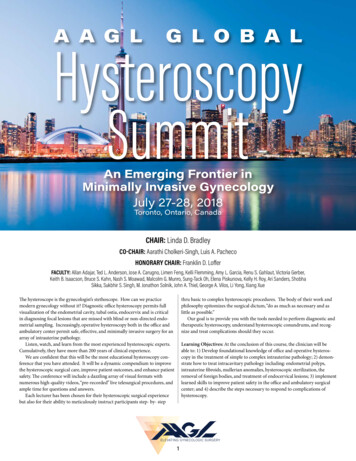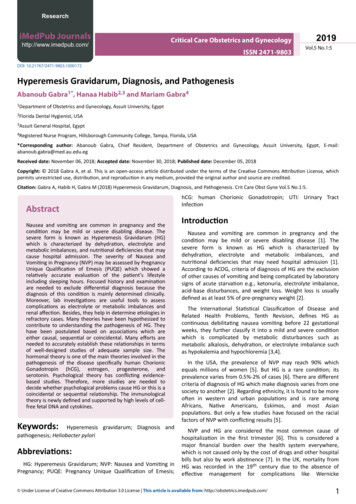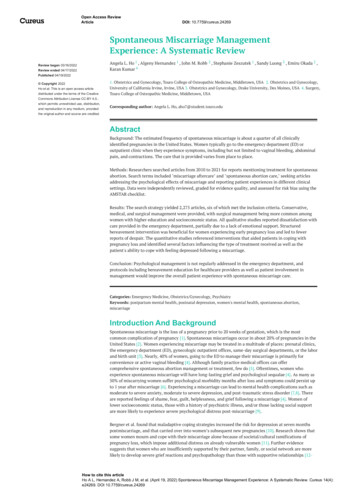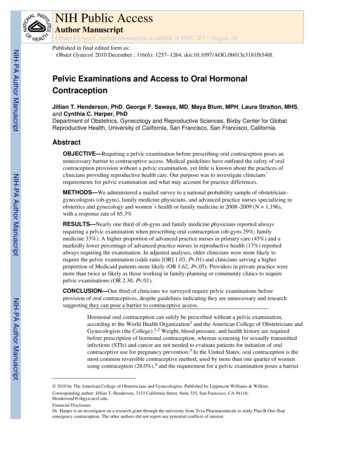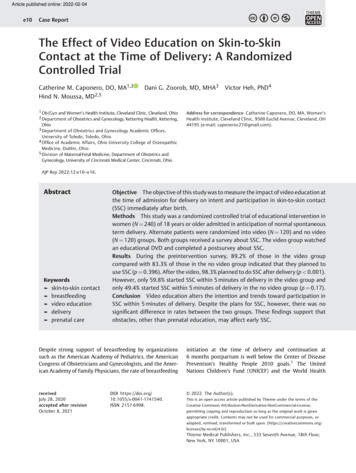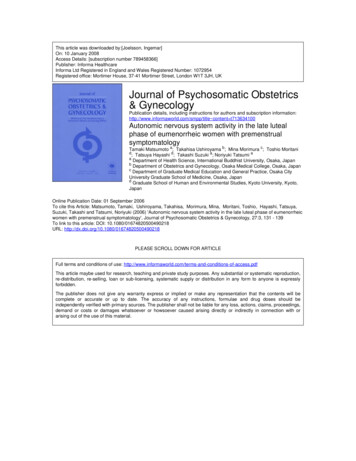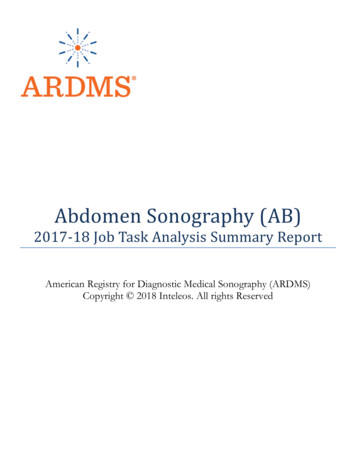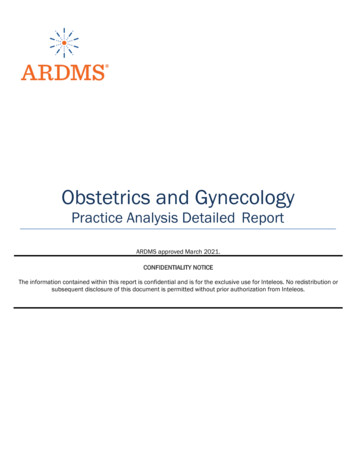
Transcription
Obstetrics and GynecologyPractice Analysis Detailed ReportARDMS approved March 2021.CONFIDENTIALITY NOTICEThe information contained within this report is confidential and is for the exclusive use for Inteleos. No redistribution orsubsequent disclosure of this document is permitted without prior authorization from Inteleos.
OB/GYN Practice Analysis ReportContentsACKNOWLEDGEMENTS . 3EXECUTIVE SUMMARY . 4BACKGROUND OF STUDY . 4METHODOLOGY . 4Selection and Profile of Subject Matter Experts . 4Workshop Panel . 4Remote Panel . 4Panelist Interviews and Workshop . 4Confirmation of Task Inventory . 5Field Survey. 5Field Survey Development . 5Field Survey Structure and Instructions to Survey Participants . 5Survey Administration Procedure and Response Rate . 5RESULTS . 6Data Analysis . 6Task Inventory Analysis. 6Demographic Analysis . 6Discussion of Results . 7Appendix A: Practice Analysis Panelists . 8Appendix B: Workshop Agenda . 9Appendix C: Instructions for Remote Panel . 10Appendix D: Task Importance Score and Committee Decision . 12Appendix E: Demographics of Survey Respondents . 20Appendix G: Content Outline . 24Revision Hisotry:2021-03-17Added ARDMS Council ApprovalInteleosPage 2
OB/GYN Practice Analysis ReportACKNOWLEDGEMENTSThank you to the subject matter expert volunteers who spent many hours developing the task inventory,evaluating the survey and responses, and reviewing the final content outline. Also, thank you to the 400Registered Diagnostic Medical Sonographers (RDMSs) certified in Obstetrics and Gynecology (OB/GYN) aroundthe world who took the time to participate in the practice analysis survey. This study was completed through theefforts of many individuals at Inteleos who worked together to construct the survey, administer the survey, andanalyze the data.InteleosPage 3
OB/GYN Practice Analysis ReportEXECUTIVE SUMMARYThe American Registry for Diagnostic Medical Sonography (ARDMS), part of the Inteleos family of certifications, is theglobally recognized standard of excellence in sonography. The ARDMS is responsible for the preparation of valid andreliable certification examinations in the field of sonography. Conducting practice analyses at the national andinternational levels allows the ARDMS to evaluate the current practice expectations and performance requirementswithin the field. The OB/GYN practice analysis collected information on the requisite OB/GYN knowledge, skills, andabilities essential to sonography professionals. The practice analysis kicked-off with a workshop held in May of 2019. Apilot survey of the task inventory developed by the workshop panel was sent to a second panel of SMEs. The practiceanalysis survey was administered in January 2021. The analysis and discussion of results by the OB/GYN AssessmentCommittee led to the recommended content outline found in Appendix F. This report details the methodology, datacollection, analysis, and the recommended updated test content outline for the OB/GYN examination based on theresults of the practice analysis.BACKGROUND OF STUDYThe ARDMS recognizes that diagnostic medical sonography is a valuable tool in the healthcare industry. There are severalhealthcare professions that utilize sonography in practice to increase the efficacy of their patient care. Successfulmastery and demonstration of the knowledge and skills required to hold ARDMS sonographer credentials will providesonographers with an additional source of validation. This will support the veracity of the diagnostic medical sonographyexams that these practitioners perform. The OB/GYN examination assesses the knowledge, skills, and abilities in theareas of the female reproductive system as well as the fetus in the first, second, and third trimesters of pregnancy asrelated to diagnostic ultrasound.METHODOLOGYSelection and Profile of Subject Matter ExpertsWorkshop PanelA panel of 12 subject matter experts (SMEs) attended an in-person workshop. The panel members were volunteers, andsome were members of the OB/GYN Assessment Committee (see Appendix A). The panel was chosen to berepresentative of the practice to the extent possible (demographic information can be found in Appendix A). 11 panelistsheld the RDMS certification in OB/GYN and one panelist was a practicing OB/GYN physician. A description of theworkshop is below.Remote PanelA second panel comprised of three subject matter experts who hold the RDMS OB/GYN certification reviewed the draftedtask inventory from the workshop and were given an opportunity to provide clarification and feedback on the tasks via anonline survey. Appendix A contains information regarding this panel. More details regarding the work of the remote panelare given below.Panelist Interviews and WorkshopStructured interviews were scheduled with panel members as schedules allowed to provide the facilitator backgroundinformation about the practice. Workshop panel members attended the in-person workshop May 30-31, 2019. SeeAppendix B for the workshop agenda. The facilitator briefed the panel on the purpose and methods of practice analyses.Panel members were led through activities to determine broad categories of work and tasks that comprise the practice ofan OB/GYN Sonographer. Using the results of these activities and discussions, the panel then developed a preliminarytask inventory.InteleosPage 4
OB/GYN Practice Analysis ReportConfirmation of Task InventoryA remote panel was assembled to review the task inventory that was developed as part of the workshop. The remotepanel was instructed to review all the tasks on the task inventory and provide feedback to improve clarity and clinicalaccuracy. The remote panel was also given an opportunity to add additional tasks to the task inventory that the workshoppanel may have omitted. The instructions to the remote panel can be found in Appendix C. There was strong agreementbetween the remote panel and the workshop panel. The remote panel only identified one task that should be clarified.One panelist was unfamiliar with four of the tasks. This feedback was included in the development of the field survey asdescribed in the next section.Field SurveyField Survey DevelopmentWorking with members of the OB/GYN Assessment Committee, Inteleos staff combined results from the remote paneland the initial task inventory from the workshop. The inventory was compared with the existing content outline to verifythat no topics were inadvertently omitted and was edited as appropriate. The final task inventory was reviewed by theOB/GYN Assessment Committee and used to build the practice analysis survey.Field Survey Structure and Instructions to Survey ParticipantsThe field survey was divided into two parts: demographic items and the task inventory items. A screening item wasused at the beginning of the survey to ensure only those actively practicing OB/GYN sonography responded to thesurvey: “Do you currently perform and/or teach OB/GYN ultrasound examinations?” Participants who selected “No”were thanked for their time and their survey ended.For the task inventory portion of the field survey, participants were asked to rate each task on scales of importance.The instructions for this section were:In the next section of the survey, you will be examining tasks associated with being an OB/GYN Sonographer, andconsider the following question:How important is this task to the practice of OB/GYN Sonography. Absolutely essential Very important Of average importance Of little importance Not important at allThe rating scale and weighting calculations are described in the Data Analysis section below.Survey Administration Procedure and Response RateThe survey was initially sent to a random sample of 3,000 RDMS registrants who are certified in OB/GYN. The surveywas open from January 15-29, 2021. The survey was available to participants as a web-based survey through thesurvey platform Qualtrics . All responses to the survey were kept confidential. 400 individuals completed the taskinventory portion of the survey. Responses from participants who did not complete the task inventory were not usedas part of the data analysis.InteleosPage 5
OB/GYN Practice Analysis ReportRESULTSData AnalysisTask Inventory AnalysisEach option for the 113 task inventory items was assigned the following importance score: Absolutely essential 5 Very important 4 Of average importance 3 Of little importance 2 Not important at all 1The mean importance score was calculated for each task (see Appendix D). Tasks were assigned to three categories toassist in the discussion of importance scores. The following instructions were provided to the committee: Green: Any task with an importance score of four or above. The committee was instructed that these tasks shouldonly be removed from the outline if they are redundant or for some other extraordinary circumstance. A rationalemust be provided if the task is recommended for removal. Yellow: Tasks with an importance score of less than four and greater than or equal to three. These tasks may bekept or removed. A rationale is required for any tasks that are removed. Red: Any task with an importance score lower than three. These tasks should be considered for removal. Arationale is required for any of these tasks that are kept.Most of the OB/GYN tasks fell into the “green” category. Ten tasks fell into the “yellow” category and there were no “red”category tasks.Initial Domain WeightingsThe mean importance scores for each task were summed within each domain. The sum of the mean importance score foreach domain was divided by the total mean importance score to determine the initial domain weightings (Table 1).Table 1. Initial Domain Weightings (Prior to Committee Call)DomainGYN Anatomy and PhysiologyOB First TrimesterOB 2nd and 3rd TrimesterProtocolsPhysics and InstrumentationTreatmentTotal# Tasks22133923115113Importance Sum98.5360.13181.33102.3744.6920.54508Initial Domain Weightings19%12%36%20%9%4%100%Demographic AnalysisResponses to demographic questions were also analyzed. Appendix E contains highlights from the demographic analysis.The analysis shows the survey respondents are representative across the dimensions of gender identification, age,location, and primary job function. The demographic analysis also provided information regarding years of experience,volume of exams performed, and the degree to which the participants’ work is devoted to Obstetrics and to Gynecology.InteleosPage 6
OB/GYN Practice Analysis ReportDiscussion of ResultsA conference call was held on February 17, 2021 with six members of the OB/GYN Assessment Committee and membersof Inteleos staff. Prior to the call, the results of the data analysis and initial content outline weightings were shared withthe assessment committee. During the call, the attendees reviewed the tasks and mean importance score, focusing onthe 11 tasks with importance scores less than four. The committee recommended removing five tasks. Four of thesetasks were in the yellow category. One task the committee recommended removing was a green task, however thecommittee felt like it was very similar to another task on the outline and would be redundant to keep it. The committeesuggested some minor changes to the wording of tasks. All edits, comments, rationales, and decisions from thecommittee can be found in Appendix D.The Treatment Domain had a low domain weighting and only five tasks. The committee recommended moving the fivetasks from this domain to the Protocols Domain under the subdomain of Sonographer Role in Procedures. They alsorecommended changing the name of the domain to Protocols and Procedures to accommodate this change. Theassociated importance weightings were added to this domain. The committee reviewed and approved the new domainweightings (Table 2) which reflect the changes outlined above. After the call new names for the domains were suggestedand approved by the committee. Original domain names are in parenthesis for reference.Table 2. Final Committee Recommended Domain Weightings and New Domain NamesDomain (Original Domain Name)GYN Anatomy and Physiology(Gynecology - Pelvic Anatomy and Physiology)Obstetrics - First Trimester(OB First Trimester)Obstetrics Second/Third Trimester(OB 2nd and 3rd Trimester)Protocols and ProceduresPhysics and Instrumentation# Tasks20Importance Sum90.46% of INAL CONTENT OUTLINEThe revised formatted content outline including domain weightings was provided to the OB/GYN Assessment Committeefor final review and approval. This report, including the final version of the content outline recommended by theAssessment Committee will go to the ARDMS Council for approval. Upon approval of the content outline, this report will beamended to include the approval date. The final recommended content outline can be found in Appendix F.Council Approval(Added 3/17/2021) Content outline was approved and will be used for the 2021 form building process (ARDMS CouncilResolution 21401).InteleosPage 7
Appendix A: Practice Analysis PanelistsTable 3. Workshop PanelFirst NameLast mandaStephenHelenCaraWinslow cCulloughMcGladeMichaelsVickeryWhittenWyboMDRDMS (OBGYN, AB, BR); RVTRDMS (OBGYN, AB)RDMS (OBGYN, AB), RVTRDMS (OBGYN, AB, BR)RDMS (OBGYN, AB, BR, VT); RVTRDMS (OBGYN, AB); RDCSRDMS (OBGYN, AB, Fem)RDMS (OBGYN,AB, BR); RDCSRDMS (OBGYN, BR)RDMS (OBGYN, AB, PS); RVTRDMS (OBGYN, AB, BR); RDCS; RVTTable 4. Remote PanelFirst NameLast atchnerRDMS (OBGYN, AB, BR)RDMS (OBGYN)RDMS (OBGYN, AB)Table 5. Gender Identification of Population and PanelistsGenderPercent in PopulationPanelistsPercent of PanelistsFemaleMale92 %8%12380%20 %Table 6. U.S. Region or Country of Population and PanelsRegion/CountryPercent in PopulationPanelistsPercent of %33%20%8%1%51441033.3 %6.7 %26.7 %26.7 %6.7 %0%8 Page
Appendix B: Workshop AgendaPractice Analysis Workshop for OBGYN ExamMay 30-31, 2019Meeting Location:Inteleos, 1401 Rockville Pike, Suite 600, Rockville, MD 20852Thursday, May 308:00 – 8:30 AMBreakfast8:30 – 9:00 AMWelcome and Housekeeping: Hannah Gibson & PanelWi-Fi AccessIntroductions9:00 - 9:30 AMOverview and Purpose of WorkshopJoe Costa9:30 – 10:00 AMReview Preliminary ReportJoe Costa How the data will be usedFeedbackItem Bank HealthGap Analysis10:00 AM – 2:00 PMReview & Revise the Prepared TaskInventoryJoe Costa & Panel12:00 – 1:00 PMLunch1:00 – 2:00 PMReview Task Inventory in QualtricsPanel2:00 – 4:30 PMFinalize Task InventoryJoe Costa & PanelFriday, May 318:00 – 8:30 AMBreakfast8:30 – 12:00 PMKnowledge-to-Task Linkage Exercise12:00 – 1:00 PMLunch1:00 PM – 4:30 PMItem Development WorkshopPanel Members Michael Bork Tania Campbell Kacy Jasper Kelly Jordan Lisa Linhart Trisha Lennox Amanda McCulloughStephen McGladeHelen MichaelsCara VickeryTed WhittenJanette WyboJoe Costa & PanelHannah GibsonInteleos Staff Joe Costa, Research Scientist Hannah Gibson, Senior ExamProgram Manager9 Page
Appendix C: Instructions for Remote PanelInstructions Regarding Clarity of Statements:You are about to review 31 statements that reflect job responsibilities of a diagnostic medicalsonographer certified in OB/GYN. Each statement will be presented one at a time.After you have read the statement, use your expert judgement to choose the most appropriateoption. Each statement will be preceded with this phrase: "Would you expect a diagnostic medicalsonographer certified in OBGYN to." The framework below is an example.Would you expect a diagnostic medical sonographer certified in OB/GYN to: [STATEMENT WILLAPPEAR HERE].You will have the following options:Yes, this statement is accurate and clear.No, this statement is inaccurate or unclear.I believe this task is not performed by a diagnostic medical sonographer who is certified inOBGYN.I am unfamiliar with this task.Guidelines on how to select the appropriate optionYou should choose option 1 if the statement is an accurate reflection of a job responsibility for asonographer certified in OB/GYN. You should also choose option 1 if after reading the statement, themeaning of the statement is clear and you would reasonably expect any sonographer certifiedin OB/GYN to interpret this statement correctly.You should choose option 2 if the statement is inaccurate. For example, in your expert opinion, youmight believe that rewording the statement will make it more accurate. You should also chooseoption 2 if the statement is unclear. If you choose this statement, you believe that a sonographercertified in OB/GYN will have difficulty interpreting the meaning of this statement. Note, if you selectoption 2, you will be given the opportunity to make the statement more accurate or more clear.You should choose option 3 if you believe the statement is outside the scope of practice for asonographer certified in OB/GYN. For example, you can choose this statement if another employee(e.g., physician) would perform this statement but not a sonographer.You should choose option 4 if you are unfamiliar with the task or uncomfortable making a judgmentof the task.Instructions Regarding Missing or Redundant Information:First, please review the entire task list in the image below. Then, below the image, select the boxnext to the statements that you believe are true.10 Page
There are tasks, performed by a diagnostic medical sonographer who is certified in OB/GYNmissing from the picture above. (1)There are duplicate or redundant tasks in the picture above. (2)If either option was selected, an open-ended text box was provided with the following prompt:You indicated that there are missing tasks or redundant information. Please provide more detail inthe box below. Which tasks would you add? Or what redundant information would you remove?11 Page
Appendix D: Task Importance Score and Committee DecisionTasks in the “Green” category have a mean importance score of four or greater. Tasks in the “Yellow”category have a mean importance score of greater than or equal to three and less than four. Tasks inthe “Red” category have a mean importance score of less than three. In general, all “green” tasksare kept, and “red” tasks are removed. The committee’s decisions are recorded above (column Dshows if they decided to keep it and column E shows any edits to the task and rationales forremoving tasks.A.Tasks B. Domain & TaskGynecology - Pelvic Anatomy and PhysiologyNormal Anatomy and PhysiologyAssess the uterus (i.e., size, position, orientation,1 contour, echogenicity)2 Assess the myometrium3 Assess the endometrium (i.e., cyclic changes)4 Assess the vagina and cervixAssess both adnexa (i.e., ovaries, fallopian tubes,5 pelvic musculature)6 Assess the anterior and posterior cul-de-sacsAssess premenarcheal, reproductive, and7 postmenopausal patientsAbnormal Physiology and PerfusionEvaluate for Müllerian duct developmentalanomalies (e.g., septated, subseptate, arcuate,8 bicornuate, unicornis uterus)Evaluate for abnormal fluid collections (e.g.,hydrometra, pyometra, hydrometrocolpos,9 hematometrocolpos, free fluid)Evaluate for uterine leiomyomas (e.g., intramural,10 submucosal, subserosal, pedunculated)Evaluate for adenomyosis and endometriosis (e.g.,11 endometrioma)Evaluate for endometrial pathology (e.g.,endometrial fluid, polyps, endometrial hyperplasia,12 endometrial carcinoma)Evaluate for cervical pathology (e.g., polyps,nabothian cysts, cervical stenosis, cervical13 carcinoma)Evaluate for vaginal pathology (e.g., Gartner cyst,14 imperforate hymen, hematometra)C.E. Cmte.Importance D.Comment orValueKeep? Rationale4.834.644.694.30YesYesYesYes4.81 Yes4.32 Yes4.44 Yes4.22 Yes4.56 YesAdded freefluid as anexample4.53 Yes4.42 Yes4.77 Yes4.38 Yes3.81 NoCovered inTask 912 Page
Evaluate other uterine findings (e.g., caesarean15 section scar, leiomyosarcoma)Evaluate for functional ovarian cysts (e.g., follicular,16 corpus luteum, theca-lutein)Evaluate for benign ovarian neoplasms (e.g.,paraovarian, cystadenoma [serous, mucinous,papillary], cystic teratoma, fibroma, thecoma,17 arrhenoblastoma)Evaluate for malignant ovarian neoplasms (e.g.,serous carcinoma, mucinous cystadenocarcinoma,papillary cystadenocarcinoma, metastatic,18 Krukenberg)Evaluate other ovarian findings (e.g., ovarian torsion,ovarian hyperstimulation syndrome, polycystic19 ovarian disease)20 Evaluate for free fluid in the pelvisAssess for pelvic inflammatory disease (e.g.,21 endometritis, pyosalpinx, tubo-ovarian abscess)Assess for intrauterine contraceptive device (IUCD)22 locationObstetrics - First TrimesterNormal Anatomy and Physiology First TrimesterIdentify structures in the first trimester obstetricalexam less than 10 weeks (i.e., decidual reaction,23 gestational sac, yolk sac, embryo, amnion)Identify fetal anatomy in the first trimesterobstetrical examination between 10-14 weeks’gestation (i.e., calvarium, brain, stomach, cord24 insertion, limbs)Identify multiple gestations (i.e., fetal number,25 chorionicity/amnionicity)First Trimester Abnormalities and Complications26 Evaluate for gestational trophoblastic disease27 Evaluate for ectopic and heterotopic pregnancy28 Evaluate for embryonic/fetal demise29 Evaluate for anembryonic pregnancy30 Evaluate for abnormal yolk sac31 Evaluate for increased nuchal translucency32 Evaluate for subchorionic hemorrhageEvaluate for intrauterine contraceptive device (IUCD)33 with pregnancyEvaluate for incomplete/missed abortion, and34 retained products of conception4.17 Yes4.20 Yes4.57 Yes4.80 Yes4.78 Yes4.27 NoCovered inTask 94.50 Yes4.54 Yes4.82 Yes4.32 Yes4.84 es4.60 Yes4.75 Yes13 Page
Assess for first trimester congenital anomalies andaneuploidy markers (e.g., Trisomy 13, 18, 21, Turner35 syndrome, triploidy)Obstetrics Second/Third TrimesterNormal Anatomy and Physiology - Second/ThirdTrimester36 Assess the placenta (i.e., size, location)Assess the umbilical cord (e.g., placental insertion,37 vessel number, fetal insertion)38 Assess amniotic fluid volume39 Assess fetal lie, presentation, and situsAssess the fetal heart (i.e., size, position, axis,chambers, valves, four-chamber view, left ventricularoutflow tract [LVOT], right ventricular outflow tract[RVOT], aortic arch, ductal arch, three vessel view40 [3VV] and three-vessel trachea [3VT] view)41 Assess the neckAssess the cranial anatomy (e.g., choroid plexus,lateral cerebral ventricles, midline falx, corpuscallosum, cisterna magna, posterior fossa, cavumsepti pellucidi, cerebellum, posterior fossa, and42 nuchal fold)Assess the face (e.g., nose, lips, chin, palate, nasal43 bone, orbits, frontal bone, profile view)44 Assess the diaphragm45 Assess the thorax (i.e., thymus, lungs)Assess the abdomen and gastrointestinal system(i.e., gallbladder, stomach, bowel, adrenal glands,46 liver, spleen)4.50 Yes4.75 Yes4.73 Yes4.70 Yes4.58 Yes4.76 Yes4.34 Yes4.79 Yes4.71 Yes4.66 Yes4.29 Yes4.53 YesAssess the skeletal system (e.g., skull, cranial47 contour, long bones, ribs, ossification)4.61 YesAssess the vertebral spine (e.g., ossification centers,48 curvature, skin covering)4.71 YesAssess the upper and lower extremities (i.e., number,49 position, digits and spacing)4.50 Yes50 Assess the genitaliaAssess the genitourinary system (e.g., kidneys,51 bladder)Fetal Abnormalities - Second/Third Trimester3.90 YesCommitteethought thiswas importantto IDpathologies4.72 Yes"Congenitalanomalies"14 Page
changed toabnormalitiesAssess abnormal multiple gestations (e.g., discordantgrowth 20%, twin to twin transfusion syndrome,selective intrauterine growth restriction [SIUGR],twin reversed arterial perfusion sequence [TRAP],twin anemia polycythemia sequence [TAPS],52 conjoined twins)Evaluate for 2nd and 3rd trimester congenitalanomalies and aneuploidy markers (e.g., Trisomy 13,53 18, 21, Turner syndrome, triploidy)54 Evaluate for abnormal amniotic fluid volumeEvaluate for abnormal fetal growth (e.g.,macrosomia, fetal growth restriction [FGR], small for55 gestation age [SGA])Evaluate for abnormal central nervous system (e.g.,ventriculomegaly, anencephaly, acrania,hydranencephaly, holoprosencephaly, Dandy-Walkermalformation, Chiari II malformation, agenesis ofcorpus callosum, encephalocele, meningocele,56 myelomeningocele, sacrococcygeal teratoma)Evaluate for abnormal face (cleft lip/palate, hyper57 /hypo-telorism, micrognathia, frontal bossing)Evaluate for abnormal neck (e.g., goiter, cystic58 hygroma)Evaluate for abnormal fetal heart (e.g., atrial andventricular septal defects, atrioventricular canaldefect, tetralogy of Fallot, transposition of the greatvessels, pentalogy of Cantrell, pericardial effusion,59 rhabdomyoma)Evaluate for abnormal diaphragm (e.g., congenital60 diaphragmatic hernia, eventration)Evaluate for abnormal thorax (e.g., hydrops, pleuraleffusion, congenital pulmonary adenomatoidmalformation, pulmonary sequestration,61 bronchogenic cyst)Evaluate for abdominal wall defect (e.g.,62 omphalocele, gastroschisis)4.78 Yes4.72 Yes4.75 Yes4.79 Yes"Assess"changed hanged to"fetal growthrestriction(FGR)"example4.80 Yes4.68 Yes4.59 Yes4.77 Yes4.69 Yes4.65 Yes4.75 Yes15 Page
6364656667Evaluate for abnormal abdomen and gastrointestinalsystem (i.e., ascites, hydrops, neuroblastoma,echogenic bowel, bowel obstruction, esophageal andduodenal atresia, mesenteric cyst)Evaluate for abnormal genitourinary system (e.g.,hydronephrosis, cystic renal dysplasia, hydroureter,renal agenesis, bladder outlet obstruction,ureterocele, ambiguous genitalia, ovarian cyst)Evaluate for abnormal skeletal system (e.g., vertebralspine, skeletal dysplasia, demineralization, limbreduction, agenesis)Evaluate for abnormal extremities including handsand feet (e.g., polydactyly, talipes, syndactyly,clinodactyly)Placental and umbilical cord abnormalitiesEvaluate for placenta previa (i.e., complete, lowlying)Evaluate for placenta abruption and infarction (i.e.,68 retroplacental, marginal)Evaluate for abnormal placental attachment (i.e.,69 placenta accreta, increta, percreta)Evaluate for abnormal placental membraneattachment, insertion, or shape (e.g., circumvallate,succenturiate, velamentous, accessory lobe, vasa70 previa)Evaluate for other placental and membraneabnormalities (e.g., thickened placenta,chorioangioma, amniotic bands, synechia, premature71 rupture of membranes)Evaluate for abnormal umbilical cord (e.g., single72 umbilical artery, nuchal cord, allantoic cysts, length)Cervix and maternal pathology4.71 Yes"Assess"changed to"Evaluate"4.73 Yes4.73 Yes4.47 Yes4.84 YesRemoved"partial" as i.e.added commabetweenretroplacentaland marginal4.79 Yeschanged "e.g."to "i.e."4.87 Yes4.69 Yes4.65 Yes"Assess"changed to"Evaluate"4.64 YesEvaluate for cervical incompetence (e.g., shortening,73 funnelin
some were members of the OB/GYN Assessment Committee (see Appendix A). The panel was chosen to be representative of the practice to the extent possible (demographic information can be found in Appendix A). 11 panelists held the RDMS certification in OB/GYN and one panelist was a practicing OB/GYN physician. A description of the workshop is below.
